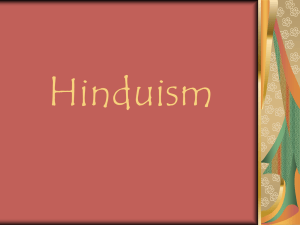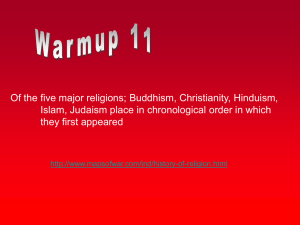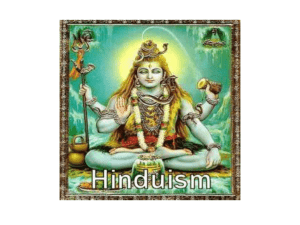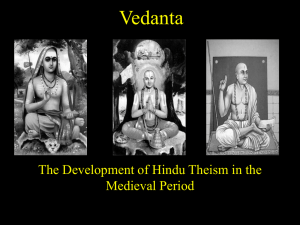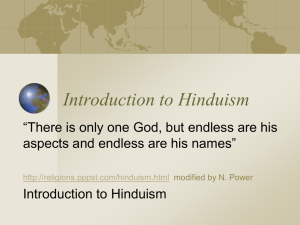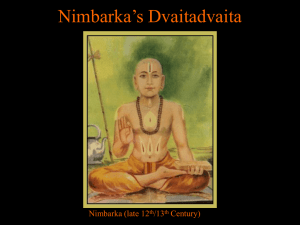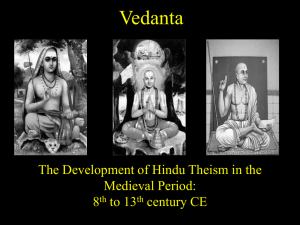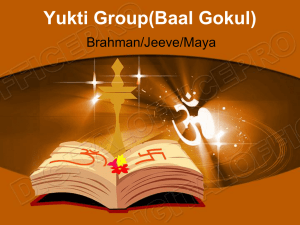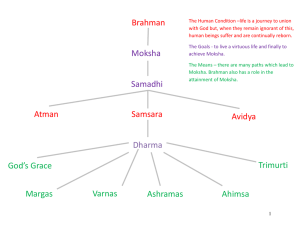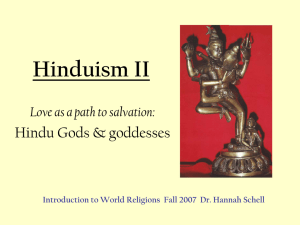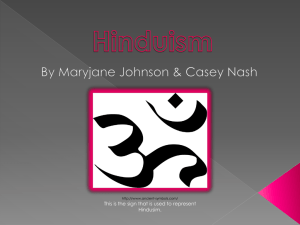Madhva - Michael Sudduth
advertisement
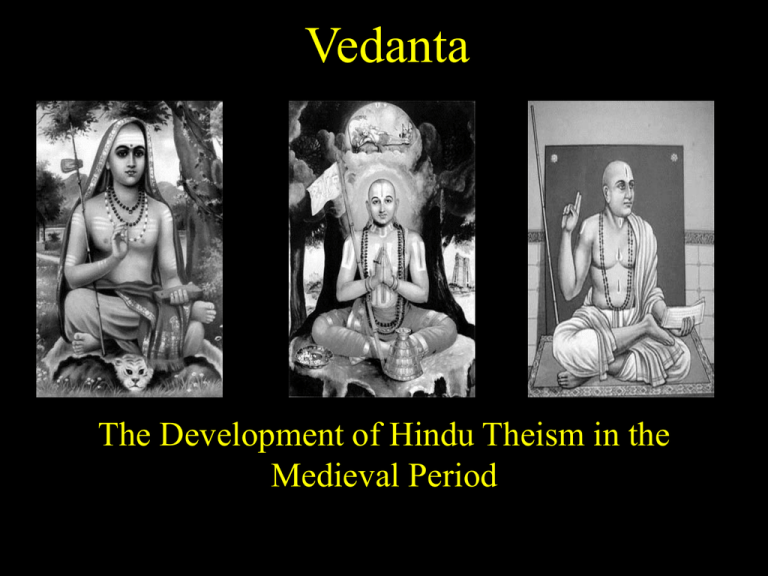
Vedanta The Development of Hindu Theism in the Medieval Period Madhva’s Dvaita Vedanta Madhva (13th Century) Madhva’s Critique of Sankara (1) Scriptural Argument The basic (Upajivya) texts of scripture teach the reality of a personal Brahman (Vishnu, Ishvara, etc.) endowed with innumerable auspicious attributes, a plurality of real jivas, and a real realm of primordial matter. Scriptural texts that assert nirguna Brahman and its fundamental unity with all other things are secondary, explanatory texts (Upadivaka) that must be read in the light of the Upajivya texts, not vice versa. The unity of the many requires the reality of the many, not their elimination. (2) Philosophical Argument from Knowledge Knowledge requires that both the knower and the object of knowledge be real. Hence, the world must be objectively real. Sankara’s denial of the objective reality of the world is mistaken. Madhva’s Critique of Ramanuja (1) If the world is a part of God, then the defects of the world would belong to God Himself. (2) But God is perfect and cannot participate in the defects of the world. Hence: (3) The world cannot be a part of God. Madhva’s philosophy is dvaita (two) and emphasizes the distinctness of Brahman and all other things. In paintings (left) Madhva is represented with his right hand raised and two fingers pointing upwards. This signifies his dualism. Brahman is a personal being wholly distinct from jiva souls and the universe of all sentient and non-sentient things. The Independent Svatantra Reality is constituted by two eternally distinct kinds of substances: Personal Brahman GOD The Independent Svatantra The Dependent Asvatantra The Dependent Asvatantra The Dependent Asvatantra Jivas Prakrti (individual souls) (nature/matter) Saguna Brahman Madhva affirms the ultimate reality of saguna Brahman (Brahman with attributes), a supreme personal being characterized by absolute independence, omnipotence, omniscience, omnipresence, and supreme goodness. On the basis of scripture, Madhva refers to Brahman by the name of Vishnu, but also as Narayana, Bhagavan, Ishvara, Purushottama, and Krishna. The Jiva and Brahman • Each jiva is an imperfect reflection (pratibimba) of Brahman with respect to the essential divine qualities of truth, consciousness, bliss. • Jivas manifest these divine qualities to different degrees. Avidya in the jiva clouds the jiva’s blissful nature and leads to the false ego. • Jivas are divided into those who finally achieve moksha (mukti-yogyas), those who remain in samsara forever (nitya-samsarins), and those Bhakti according to Madhva “Bhakti is that continuous flow of the heart that has been liquefied by love towards God, which is preceded by a deep understanding of the majesty, omnipotence of the one Independent Entity on whom all the universe depends and has its being, which is unshakably rooted in the object of love, and which cherishes Him as the most supreme value.” ~ Madhva Bhakti according to Madhva (1) Devotional Practices Hearing about God’s majesty Singing God’s praise Silent repetition of God’s name Worship of holy images Salutation of his presence in all beings Cultivating the attitude of servantship Intimacy with him Whole-hearted offering of oneself to God Bhakti according to Madhva (2) Pakva-bhakti: Continuous meditation on the self as a reflection of God, as wholly dependent on God (either through an external image, within oneself, or everywhere). This activity produces jnana, of Jiva’s intrinsic nature as consciousness and bliss Jiva’s absolute dependence on God Study of the scriptures (shravana) and reflection (manana) are important to this process. Bhakti according to Madhva (3) Pakva-bhakti leads to paripakva-bhakti or consummate devotion. This involves meditation (dhyana) on God’s attributes. It is a means to the direct vision of God (aparokshajnana). (4) Ati-paripakva-bhakti or mellow devotion in which the direct vision of God (aparokshajnana) is achieved. This is communion with God. God reveals Himself. Dhyana and Aparoksha Madhva distinguished between Dhyana: knowledge of God mediated by mental pictures constructed by the human mind Aparoksha: knowledge of God that is the direct vision or revelation of God Dhyana gives rise to aparoksha by God’s grace, as a response to loving devotion. Moksha • Direct perception of God leads to moksha. • In moksha, the jiva retains its individuality and continues to experience bhakti. No absorption or merging into Brahman. • All jivas released from samsara at death enter into the Supreme Abode known as Vaikuntha, but since there are gradations (taratamya) of bliss, there are different modes of liberation experience in Vaikuntha.
